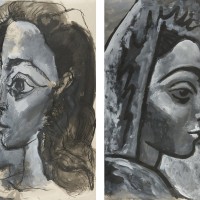-
Sotheby’s Drawn Into International Art Feud Between Russian Billionaire and Swiss Freeport Magnate
06/09/2016
 A dispute between two powerful figures in the international art world has been playing out on a global stage for months. Now, a major auction house has been dragged into the fray, sparking even more debate about the role of confidentiality in a market that often operates with minimal transparency and places a premium on secrecy.
A dispute between two powerful figures in the international art world has been playing out on a global stage for months. Now, a major auction house has been dragged into the fray, sparking even more debate about the role of confidentiality in a market that often operates with minimal transparency and places a premium on secrecy.
The central characters in the story are Dmitry Rybolovlev, a Russian billionaire, and his onetime art dealer, Swiss businessman Yves Bouvier. In 2014, the two had a highly-publicized falling-out after Rybolovlev accused Bouvier of defrauding him by overcharging him as much as $1 billion for dozens of pieces of art. According to Rybolovlev’s version of events, Bouvier had helped Rybolovlev to amass an incredible collection of art ranging from Rothko to Klimt to da Vinci.
But the pair’s relationship collapsed after Rybolovlev learned, by chance through the grapevine, about a Modigliani that had been sold by another billionaire for $93.5 million. It turned out that the work was the same one Rybolovlev had recently bought—in a purchase arranged by Mr. Bouvier—for $118 million. Rybolovlev says he was shocked by the markup, because he thought Bouvier was acting as his agent in such transactions, negotiating the best price on Rybolovlev’s behalf and taking a flat two percent fee for those services, based on the purchase price. Rybolovlev claims that he has since learned that Bouvier pocketed an exorbitant markup on many other sales as well. Bouvier, for his part, says that he was an independent seller who was free to buy and resell art for as much as the market would bear, and that Rybolovlev was a sophisticated collector fully capable of protecting himself. The feud has since led to litigation in Paris, Monaco, Singapore and Hong Kong; in fact, Bouvier was arrested in Monaco last year in connection with the case, but was promptly released on bail. And earlier this spring, U.S. authorities also launched an investigation into Bouvier’s dealings (one of several investigations that seem to signal increased scrutiny of art transactions).
The Rybolovlev-Bouvier scandal has garnered fascination not only because of the rare masterpieces and astronomical prices involved, but because it has highlighted some of the most opaque aspects of the high-end art market. The dispute is an extreme illustration of the lack of transparency in many art transactions, in which buyers and sellers often do not know one another’s identities, and deals are done through intermediaries who charge various markups. (See here and here for examples of other recent high-profile disputes that arose when collectors felt that “their” dealers were less than frank about the dealers’ own interests in a transaction.)
The Bouvier case has also resulted in increased public scrutiny of “freeports”—high-tech warehouses where wealthy art collectors can store their works and sometimes postpone or avoid taxes or customs— because Bouvier, in addition to acting as an art advisor and dealer, also runs and owns a significant stake in several freeports. Indeed, until relatively recently, he was primarily known in the art arena as a leader in storage and logistics, not a dealmaker himself; this dual role has been criticized by some who feel it presents an inherent conflict of interest.
Recently, the Bouvier affair’s ripples have been rocking the boat at Sotheby’s, one of the world’s top auction houses. In late March, two entities controlled by Rybolovlev filed an application in federal court in the Southern District of New York, seeking discovery in aid of various foreign civil and criminal proceedings against Bouvier. Specifically, the request sought information connected to the sale of a major painting, Leonardo da Vinci’s Christ as Salvator Mundi, which ended up in Rybolovlev’s collection and is now a focal point in the Bouvier/Rybolovlev dispute. The Rybolovlev entities sought discovery from the sellers—prominent New York dealers Warren Adelson, Alexander Parish, and Robert Simon—and from Sotheby’s, which brokered that sale and, apparently, several others involved in the feud. In response, in mid-May, the three dealers filed an opposition, and Bouvier also intervened in the suit and argued against the discovery. See In re Accent Delight International Ltd. and Xitrans Finance Ltd., 1:16-mc-00125-JMF (S.D.N.Y. 2016). But Sotheby’s did not. Rather, they apparently negotiated with the Rybolovlev entities and agreed to limited discovery, subject to approval by a federal judge.
Sotheby’s course of action has been met with consternation by some in the art world, who feel that Sotheby’s should have fought the request in court. (Relatedly, Bouvier had filed a similar request for discovery last fall, seeking information from Manhattan art consultant Sanford Heller and two Heller-affiliated entities, whom Bouvier claimed had played an advisory role in one of the disputed transactions between Rybolovlev and Bouvier. See In re Application of Yves Bouvier and MEI Invest Ltd., 1:15-MC-00312-DLC (S.D.N.Y. 2015). The Heller parties opposed the request, and the judge in that case ordered only limited discovery.
We’ll continue to watch the case, but in the meantime, it serves as a reminder that parties to art transactions need clear contracting in advance to lay out the understandings and assumptions on which they’re doing business in this complicated arena.
Art Law Blog
